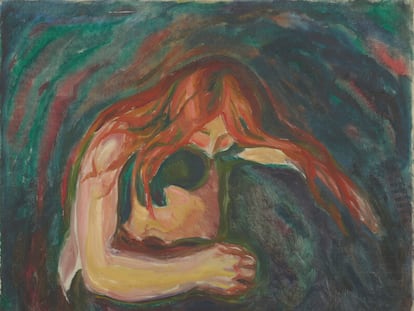How Edvard Munch grew up amidst the ‘Goyamania’ that made the Spaniard a pioneer of modern art
An exhibition in Oslo puts the work of both painters in dialogue. And, in the city of Stavanger, another exhibit recently displayed the work of Spanish painter Eugenio Lucas in context with the Norwegians Lars Hertervig and Peder Balke
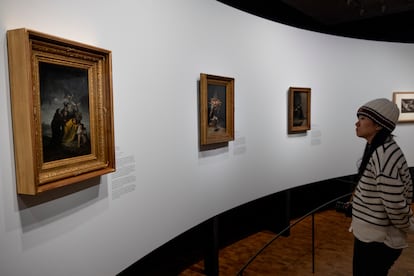

What did Francisco de Goya and Edvard Munch have in common? In principle, not much. The Spanish romantic artist and the Norwegian painter lived in separate times and spaces. The latter was born 35 years after the death of the first one… and he wasn’t a fan of recognizing the influence of Goya. Still, common threads exist between the two men.
“The connection is that Goya was rediscovered in Munch’s time,” explains Trine Otte Bak Nielsen, curator of the Oslo-based exhibition Goya and Munch: Modern Prophecies. Much of the Spaniard’s work only came to be known after his death. For example, his Black Paintings — 14 in all — were transferred to canvas in 1873, nearly 50 years after his death. The Disasters of War — a series of 82 prints — was published for the first time in 1863. When they came out, they were considered to be entertainment, without much artistic value. The prints can be seen in the aforementioned exhibition, at the Munch Museum in Oslo, until February 11. EL PAÍS visited the exhibition, on a trip financed by the Norwegian Embassy in Spain.
The discovery of Goya by the general public caused something like a “Goyamania” in Munch’s time, at the end of the 19th century, with several exhibitions of the Spaniard’s work being held throughout Europe. Goya finally became truly known beyond Spain, in a richer dimension. “This was a darker and more symbolic Goya… not so much a painter of the court,” the curator clarifies. “He began to be understood as a pioneer of modernity.”
Munch — who lived from 1863 until 1944 — was one of the modern artists of the moment. Various publications dedicated to Goya’s work were found in Munch’s library. The poet Charles Baudelaire — as explored in the exhibition — was one of the first to understand Goya in that sense. He saw that the Spaniard had an imagination that broke with the sober realism of the time and led to other more poetic places. There was existential depth to his work… a liberation of the psyche. A higher flight for the visual arts.
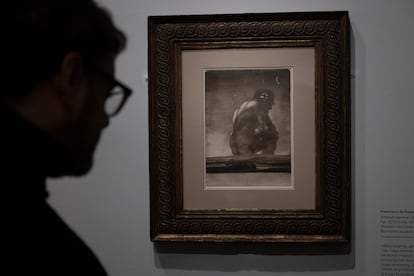
The exhibition in Oslo doesn’t try to affirm a direct connection between the two, but rather points to Goya’s influence on the zeitgeist of Munch’s time. From there, certain parallels can be drawn on thematic or technical issues. For example, Goya influenced the Symbolists, who, in turn, influenced the early stages of Munch’s career. In the exhibition, there are sections where the social realism of both painters — or their love for supernatural themes — are juxtaposed (as seen, for example, in Goya’s Witches’ Sabbath and Munch’s Love and Pain). The Goyesque Disasters of War are exhibited together with some works by the Norwegian that were inspired by disasters resulting from other wars: World War I, or the Finnish Civil War.
According to the curator, among the shared techniques are the use of pure colors applied quickly, noticeable brushstrokes, shading, or the free use of lines in engravings. Both artists also suffered personal crises that conditioned their work and its reception in posterity.
This is the first time that the Munch Museum puts the Norwegian painter in a historical context prior to his birth. Another unexpected Spanish connection of Munch is the museum itself, inaugurated in 2021, whose iconic building is the work of architect Juan Herreros, a Spaniard. His project changed the skyline of Oslo in what was once its port area.
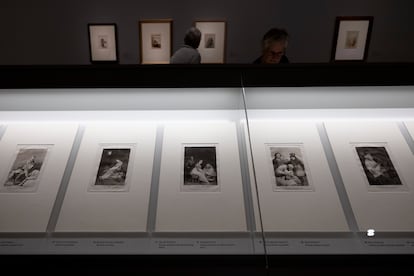
The inner landscape of the mind
Here’s a curious coincidence: another exhibition featuring Spanish painters in dialogue with Norwegian painters also recently took place in the Norwegian city of Stavanger, on the west coast of the country, flanked by fjords. Until December 31, the local art museum was displaying a collection of works that was previously inaugurated at the Lázaro Galdiano Museum in Madrid. Titled Romantic Visionaries, it was curated by Knut Ljøgodt and Carlos Sánchez Díez. In the exhibit, Spanish painter Eugenio Lucas Velázquez was put in context with the Norwegian artists Peder Balke and Lars Hertervig. The latter was a source of inspiration for the latest winner of the Nobel Prize in Literature, Jon Fosse. His book Melancholy is about a young Hertervig.
What are the connections in this case? Well, all three painters lived in the 19th century, although there’s no evidence that each knew the others’ work. But all three are part of the tradition of Romanticism: they were focused on the representation of landscapes. They were visionaries in the sense that they didn’t try to reflect those landscapes realistically, but rather, they projected onto them the landscape that was inside their minds, in the style of other romantics, such as J.M.W. Turner, or Caspar David Friedrich.
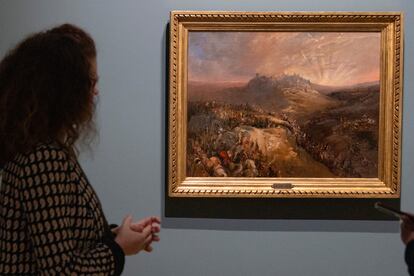
“It’s about identifying a phenomenon — this chapter in the history of art — which perhaps isn’t too well known, but which was transnational. These creators — although they’re part of the Romantic Movement — go one step further: it’s not only that they paint interior landscapes… it’s how they experiment with form and technique to achieve it,” explains Ljøgodt, head of the Nordic Institute of Art. He was the organizer of the exhibition, together with the Hispanic Europe Studies Center and the Lázaro Galdiano Museum.
The spirituality that exudes from the works of Lucas, Balke and Hertervig isn’t only reflected in the use of certain motifs and symbols (they painted — like so many Romantics — shipwrecks, lighthouses, ruined castles, or dying trees), but in the technique itself. Balke’s had an almost-monochrome style, achieved through the elimination of layers. Hertervig used watercolor and gouache, often on coarse bases, such as tobacco wrapping paper or packaging material. In Lucas’ ultimate abstraction, the landscape motif seems to almost disappear, until it becomes a stain. They all searched for new ways of expression… an experimentalism that seems to precede other later trends, such as abstract expressionism.

“Another connection is that their works weren’t made for public exhibition. They were all done in private, which means that the artists were able to freely express their ideas. They weren’t thinking about the market,” Ljøgodt notes. So much so that their works have often been considered mere studies or sketches, perhaps also due to their small size, their informality, or their desire for experimentation. While the quick sketch has been a common tool in landscaping, the curators affirm that the authors conceived these paintings as artworks in their own right.
Balke and Hertervig weren’t taken seriously in the art scene of 19th century Norway. Hertervig — who suffered from schizophrenia — led a troubled and clandestine life. This forced him to live in frequent precariousness, in the quiet city of Stavanger, far from artistic circles. Some relate the semi-fantastic character and the visionary nature of his work with his mental condition. The memory of both painters was recovered in Norway more recently.
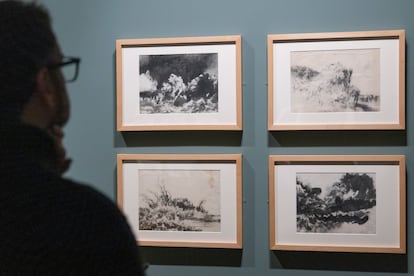
Lucas, on the other hand, was an established artist in Spain at the time, although he was largely forgotten during the course of the 20th century. For the curators, these artists — part of “a forgotten chapter of Art History” — didn’t receive the attention they deserved and were left out of the linear narrative of the artistic canon due to their visionary and experimental character… precisely what their exhibition tried to celebrate. Also, like Goya, they can be described as precursors to modern art.
Sign up for our weekly newsletter to get more English-language news coverage from EL PAÍS USA Edition
Tu suscripción se está usando en otro dispositivo
¿Quieres añadir otro usuario a tu suscripción?
Si continúas leyendo en este dispositivo, no se podrá leer en el otro.
FlechaTu suscripción se está usando en otro dispositivo y solo puedes acceder a EL PAÍS desde un dispositivo a la vez.
Si quieres compartir tu cuenta, cambia tu suscripción a la modalidad Premium, así podrás añadir otro usuario. Cada uno accederá con su propia cuenta de email, lo que os permitirá personalizar vuestra experiencia en EL PAÍS.
¿Tienes una suscripción de empresa? Accede aquí para contratar más cuentas.
En el caso de no saber quién está usando tu cuenta, te recomendamos cambiar tu contraseña aquí.
Si decides continuar compartiendo tu cuenta, este mensaje se mostrará en tu dispositivo y en el de la otra persona que está usando tu cuenta de forma indefinida, afectando a tu experiencia de lectura. Puedes consultar aquí los términos y condiciones de la suscripción digital.
More information
Archived In
Últimas noticias
Welcome to the post-religion era: The idea of Christianity as the absolute truth has become obsolete
‘I thought you would like it’: The risky sexual practice popularized by TV shows and TikTok
The digitalization of tourism: ‘They promise experiences and gave us the worst possible one’
Mexican peso defies uncertainty with forecasts of a new period of stability in 2026
Most viewed
- Sinaloa Cartel war is taking its toll on Los Chapitos
- Oona Chaplin: ‘I told James Cameron that I was living in a treehouse and starting a permaculture project with a friend’
- Reinhard Genzel, Nobel laureate in physics: ‘One-minute videos will never give you the truth’
- Why the price of coffee has skyrocketed: from Brazilian plantations to specialty coffee houses
- Silver prices are going crazy: This is what’s fueling the rally
